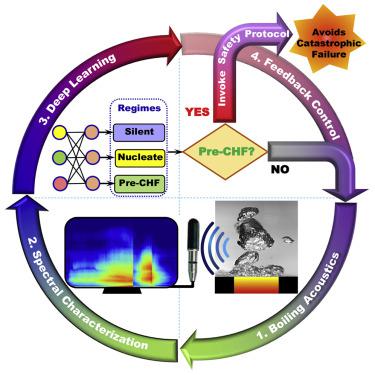Cell Reports Physical Science ( IF 7.9 ) Pub Date : 2021-03-17 , DOI: 10.1016/j.xcrp.2021.100382 Kumar Nishant Ranjan Sinha , Vijay Kumar , Nirbhay Kumar , Atul Thakur , Rishi Raj

|
Advance prediction of boiling crisis is critical to the safety and economy of many thermal systems. Here, we perform steady-state near-saturated boiling experiments on a plain copper surface and acquire the acoustic emissions (AEs) in natural convection, nucleate, and transition boiling regimes. We use the corresponding AE spectrograms to train a convolutional neural network, which shows a validation accuracy of 99.92% against the ground truth. We next evaluate the trained network on experiments with water and aqueous solutions of ionic liquid and surfactant on plain and nanostructured copper surfaces with time-varying heat inputs. Despite the variations in boiling surfaces, working fluids, and the heating strategy between the training and the evaluation datasets, the network accurately predicts the respective boiling regimes. Finally, we use the insights to perform advance prediction of boiling crisis for mitigating thermal runaway-induced accidents in boiling-based systems.
中文翻译:

深度学习沸腾的声音,提前预测沸腾危机
沸腾危机的提前预测对许多热力系统的安全性和经济性至关重要。在这里,我们在普通的铜表面上进行稳态近饱和沸腾实验,并获得自然对流,成核和过渡沸腾状态下的声发射(AE)。我们使用相应的AE频谱图来训练卷积神经网络,该神经网络针对地面真实性显示出99.92%的验证准确性。接下来,我们将评估受训网络在离子液体和表面活性剂的水和水溶液的情况下,在具有时变热输入的纯铜和纳米结构铜表面上的实验结果。尽管沸腾表面,工作流体以及训练和评估数据集之间的加热策略有所不同,但该网络仍可以准确地预测各自的沸腾状态。最后,











































 京公网安备 11010802027423号
京公网安备 11010802027423号